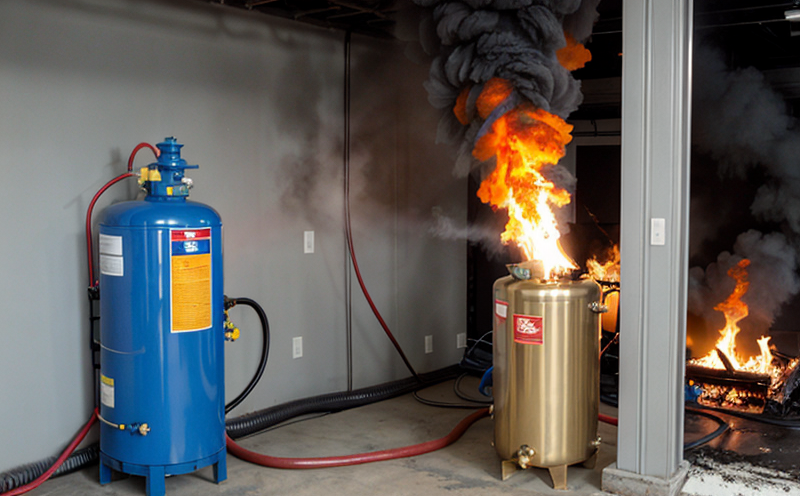Fire Suppressant Agent Storage and Handling Testing
Fire suppressant agent storage and handling testing is crucial in ensuring that fire safety systems are reliable and effective. This type of testing ensures the integrity, stability, and performance of fire suppression agents over their shelf life. Properly stored and handled agents can significantly enhance a facility's ability to combat fires effectively, thereby minimizing property damage and loss of life.
The importance of this service cannot be overstated in sectors such as manufacturing, healthcare, hospitality, and government buildings where the risk of fire is high. By simulating real-world conditions, our testing ensures that agents remain potent and ready for use when needed. This includes assessing the physical properties of the agent, its compatibility with storage containers, and its stability over time.
The testing process involves several critical steps. First, the agent is subjected to various environmental conditions such as temperature, humidity, and exposure to light. These conditions mimic those found in typical storage environments within facilities. The purpose is to observe any changes in the agent’s physical properties that could affect its efficacy during a fire suppression event.
Next, the handling tests evaluate how the agent behaves under different loading and unloading scenarios. This ensures that the agents can be safely and efficiently transported and deployed without compromising their integrity. The testing also includes assessing compatibility between the suppressant and the storage containers to prevent any chemical reactions that could render the agent ineffective.
The results of these tests are meticulously recorded and compared against international standards such as ISO 17654, which provides guidance on fire extinguishing agents used in portable fire extinguishers. These standards ensure consistency and reliability across different testing facilities and products.
Proper storage and handling practices are essential not only for the safety of personnel but also to comply with regulatory requirements. Non-compliance can lead to penalties, fines, and reputational damage. By partnering with us, you ensure that your fire suppression systems meet the highest standards of quality and reliability.
- Ensures agent stability over time
- Evaluates physical properties under various environmental conditions
- Assesses compatibility between agents and storage containers
- Evaluates handling and loading/unloading procedures
- Complies with international standards for fire extinguishing agents
Applied Standards
In the context of fire suppressant agent storage and handling testing, adherence to specific standards is paramount. The primary standard used in our laboratory is ISO 17654:2019 "Fire extinguishing agents - Classification and marking." This international standard provides a framework for the classification and marking of fire extinguishing agents based on their type, quantity, and intended use.
Additionally, we align with ASTM E835-21 which specifies the procedure for determining the thermal stability of fire extinguishing agents. This ensures that the agent remains effective under high temperatures encountered in real fire scenarios. Another relevant standard is IEC 60479-1:2016, which covers the classification and marking of fire extinguishing agents based on their chemical composition.
Our testing procedures are meticulously designed to adhere strictly to these standards. This ensures that our clients receive accurate results that can be relied upon for regulatory compliance and internal quality control purposes. By following these internationally recognized guidelines, we provide a level of assurance that is critical in maintaining the integrity of fire safety systems.
Scope and Methodology
The scope of our testing encompasses both the physical properties of the fire suppressant agents and their handling under various conditions. We begin by subjecting the agent to a range of environmental stresses, including temperature variations from -10°C to +50°C, humidity levels up to 93%, and exposure to light for extended periods.
The physical properties we assess include viscosity, density, flash point, boiling point, and surface tension. These parameters are crucial in determining the agent's behavior during a fire suppression event. For instance, if an agent is too viscous or has a low boiling point, it may not perform optimally under certain conditions.
Handling tests are conducted to evaluate how the agent behaves when loaded into and unloaded from storage containers. This includes assessing the rate of discharge, the uniformity of distribution, and any potential for clogging or blockage in delivery systems. These tests ensure that the agent can be deployed efficiently and effectively during an emergency.
The methodology we employ is based on rigorous testing protocols that have been validated by leading experts in fire safety technology. Our laboratory facilities are equipped with state-of-the-art instrumentation to accurately measure and record all relevant parameters. The results of these tests are then analyzed against the applicable international standards to ensure compliance and reliability.





